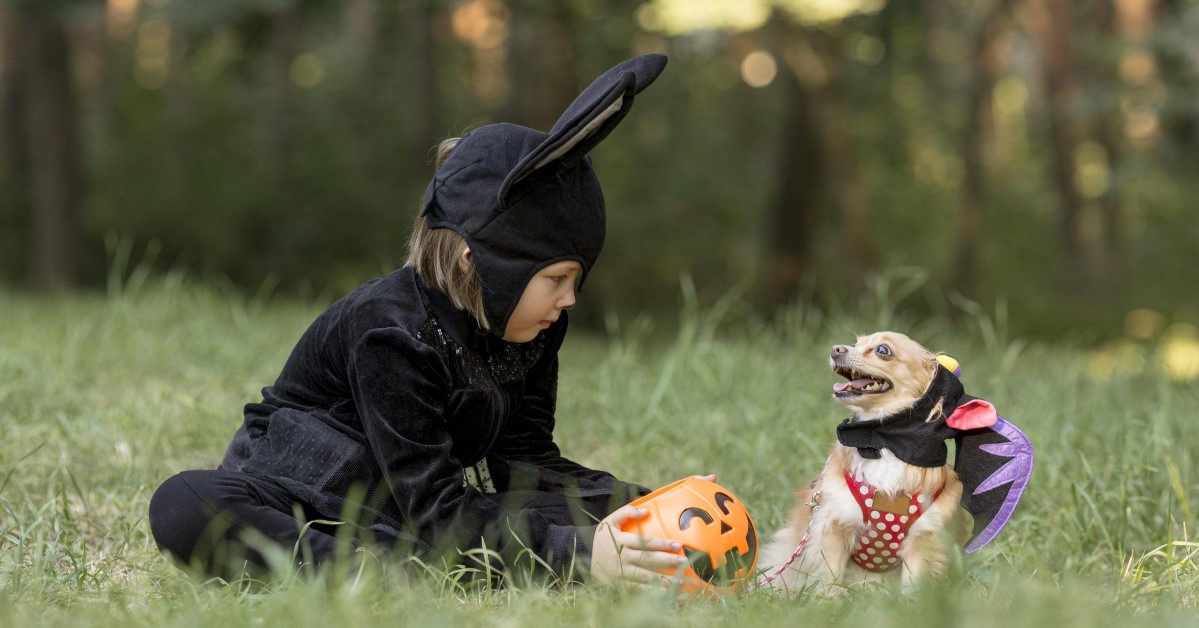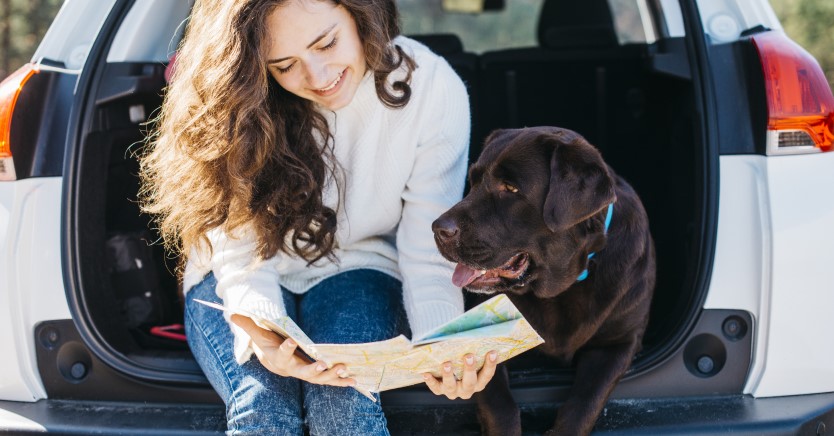Trick-or-Treat: Should You Bring Your Dog Along?
Trick-or-treating can be fun for you and your dog if you follow a few simple safety tips.

Halloween isn’t just for humans. Pets, too, can enjoy this spooky holiday! You may even want to bring Fido along as your children trick-or-treat around the neighborhood. But should you take your dog trick-or-treating? Well, it depends. Before heading out on October 31 for an epic Halloween adventure, keep the following safety tips in mind.
Do What’s Best for Your Dog
Not all dogs respond well to the strange noises, smells, and sights associated with Halloween. It’s important to consider if your dog can handle an evening of trick-or-treating without experiencing stress or exhibiting poor behavior.
First, consider your dog’s age. Trick-or-treating typically involves a lot of walking from door to door. Some older dogs may not have the stamina needed to keep up with fast-paced kids. You’ll also want to think about the temperament of your pet. Some dogs become anxious in unfamiliar situations, may become aggressive around other pets they come across, or may not feel comfortable with the sounds of children squealing or Halloween décor.
If your dog has gone trick-or-treating with your family in the past, it’s safe to say that he’ll probably be fine. However, if you have any doubts about your dog’s tolerance, consider hiring a pet sitter for the evening.
Safety Tips for Trick-or-Treating with Your Pet
For many sociable pets, trick-or-treating can be an enjoyable experience. Be prepared for whatever situation arises with the following safety tips:
1. Pack the Essentials
Just like you would pack juice boxes or wet wipes for your kids, you’ll need to pack a few must-haves for your pup. Bring along a water bottle, a bowl to drink from, snacks, and maybe a toy to keep his attention. You’ll also want bags to pick up your pet’s waste. If the weather is chilly, a sweater may help keep your dog warm.
2. Ensure that Your Pet Can Be Identified
If your pet gets lost during trick-or-treating, you’ll want to ensure that she can be found quickly. Before Halloween, get your pet microchipped if you haven’t already and check that the information linked to the microchip is up-to-date. You’ll also want to attach ID tags to your pet’s collar with her name, address, and phone number.
3. Keep Your Dog Visible
The streets can be chaotic on Halloween night, and you certainly will not want to lose track of your dog. Consider putting reflective tags on his collar or have him wear a reflective vest for optimal visibility. If you’re trick-or-treating in an area with few street lights, consider bringing along a flashlight.
4. Stick to Walking Paths and Sidewalks
Walking on the road on Halloween can be dangerous. Even if you think that vehicles can see you, distractions from running children and spooky Halloween décor can quickly distract drivers. Remember to keep your dog on a leash at all times and stick to safe walking paths and sidewalks.
5. Choose Dog Costumes Carefully
Today, it’s easy to find costumes for your pet regardless of size or breed. Some dogs do not like wearing costumes, and it’s important not to force them to dress up if they are not comfortable. If your pet doesn’t mind dressing up, choose a costume that will not restrict his ability to see, breathe, hear, bark, or move.
6. Don’t Share Candy with Pets
While a big part of trick-or-treating is candy, it’s important to remember that candy is not healthy for dogs. Some types of candy, such as chocolate, can be poisonous. Remind your children not to share their candy with the dog, even if the dog begs. You can make it fun for Fido by bringing along some homemade dog treats to give him on occasion.
7. Be Mindful of Fire Hazards
On Halloween, it’s common to see jack o’ lanterns lit up with candles. Some houses may even have Halloween decorations that incorporate candles or fire. When walking your dog near these homes, be careful not to get too close.
8. Do Not Accept Dog Treats from Strangers
Just like you wouldn’t allow your children to eat homemade treats from strangers, it’s best not to allow your dog to scarf down treats from people you don’t know. Although the treat may not be harmful, it could contain a food allergy that you are not aware of or large amounts of sugar. Kindly say “no thanks” and be on your way.
9. Practice Your Dog’s Training Cues
If your pet is a little rusty on his basic training cues, consider practicing in the days and weeks leading up to Halloween. Some of the most important cues that your pet should know include wait, sit, stay, come, and release. Remember that it takes time for your dog to pick up specific cues, and you can’t expect it to happen overnight. Long-term, consistent training is key to a well-behaved pup.
10. Know When to Quit
While your dog may have fun trick-or-treating for the first few blocks, he may start to lose interest or become irritable. When this happens, you’ll want to have an adult bring the dog back home or lead him away from people to a quiet area where he can de-stress. It can be helpful to give your dog frequent breaks from trick-or-treating to lie down, enjoy a snack, or sniff the grass.
Enjoying Halloween with Your Pet
Few things are more precious than a dachshund dressed like a hot dog or a golden retriever with a flowing lion’s mane. If you want to include your dog in your Halloween festivities, be our guest! Just remember to follow these simple safety tips to protect your pet while trick-or-treating.
Ready to start saving money on pet wellness care?
Then take a look at Mint Wellness, the pet wellness plan that provides fast reimbursement on routine pet care. Save on vaccinations, wellness exams, preventatives, dental, and more!
Learn More


